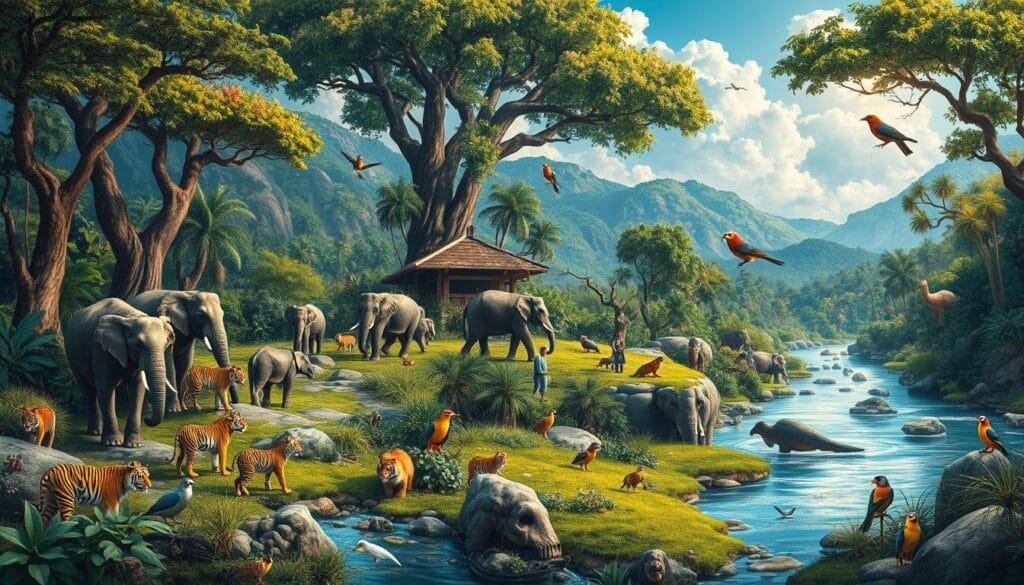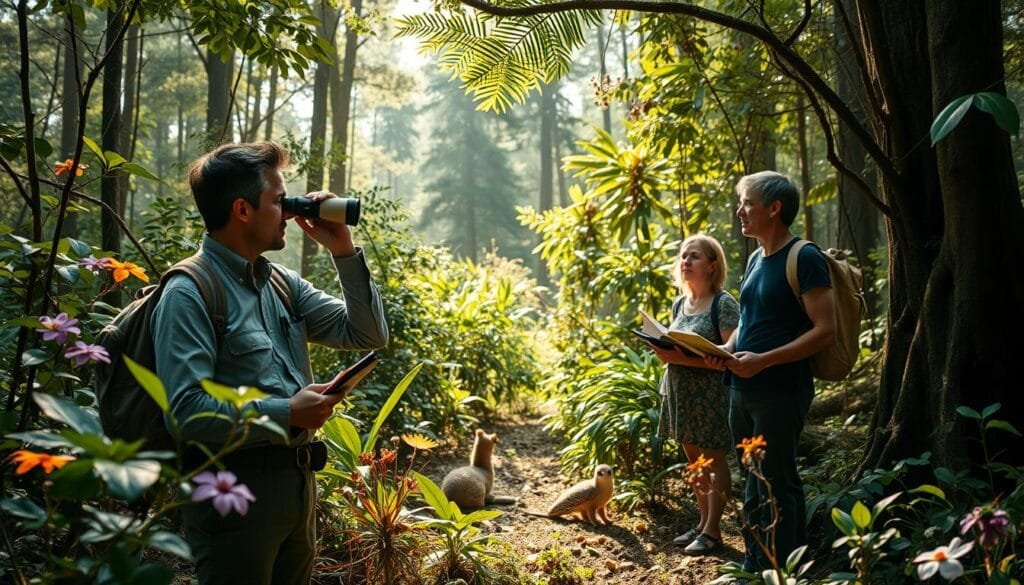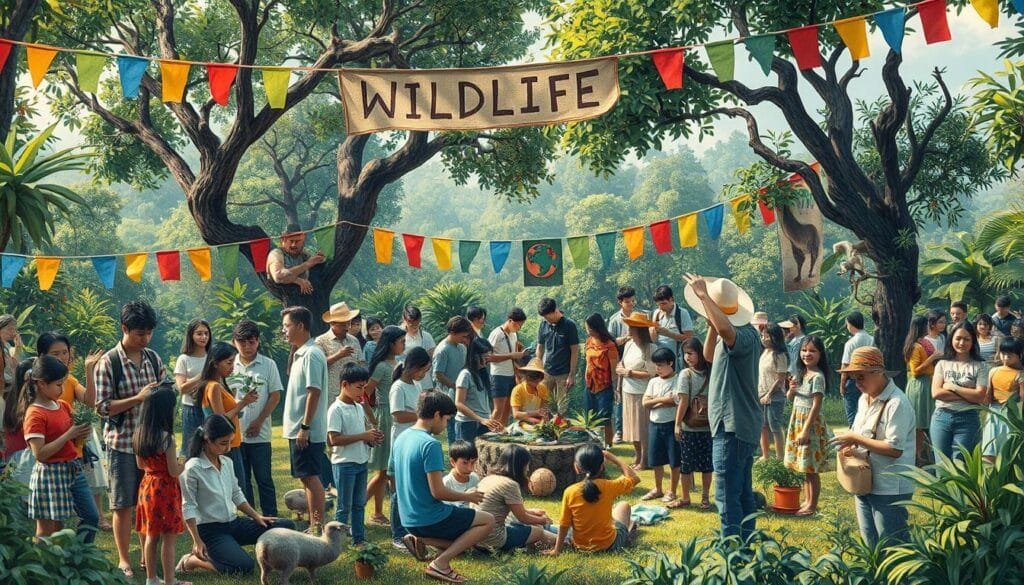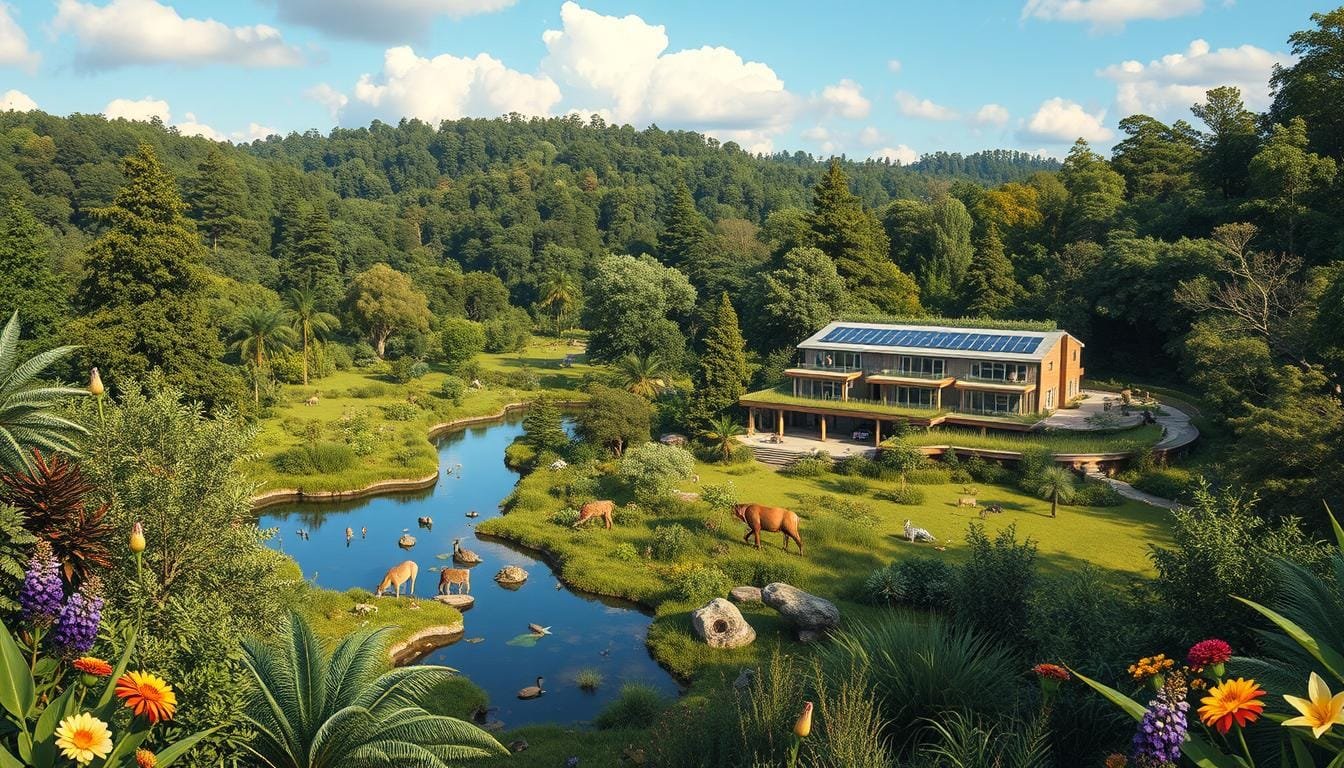The Wildlife Conservation Society (WCS) works hard to protect animals and nature all over the globe. If you’re looking to help or visit, it’s key to know where they are and what they do. This guide will help you understand WCS and its crucial conservation work.
Since starting in 1895, WCS has kept many species and habitats safe. It’s changed a lot over time, showing its deep commitment to nature. Looking at its finances, in 2009, WCS had a total of $891,582,872 in assets. By 2017, assets grew to $967,697,634. This shows how much WCS’s efforts have expanded.
Key Takeaways
- WCS was founded in 1895 to protect wildlife globally.
- The organization’s financial assets and liabilities have seen significant changes from 2009 to 2017.
- Contributions to WCS grew from $54,168,841 in 2009 to $100,513,503 in 2015, reflecting increased support for their mission.
- The WCS guide offers insights into the location, services, and worldwide conservation efforts.
- WCS’s substantial grants have supported marine conservation and sustainable development in various countries.
Introduction to the Wildlife Conservation Society
The Wildlife Conservation Society (WCS) is a leader in saving wildlife and their homes. It started in 1895 in New York. Today, WCS tackles modern conservation challenges.
Conserving wildlife is at the heart of WCS’s work. They run programs and plans to fight biodiversity loss and climate change.
What is WCS?
WCS focuses on protecting animals and wild areas around the globe. Since changing its name in 1993, its mission has grown. WCS works hard to save habitats, species, and engage with communities.
With 3,700 team members, WCS works in over 50 countries. They use special tools and financial plans to keep nature safe.
Why Conservation Matters
Conserving wildlife is key in our world. WCS helps keep ecosystems healthy and protects many species. Their projects cover important areas like the Caribbean and Indonesia, working on marine spots such as reefs.
WCS teams up with governments, groups, locals, and experts to strengthen their work. Together, they make a big difference.
Between 1988 and 2019, WCS gave out 94 grants totaling $37,825,000. Each year, they spend about $791,146.78 on conservation. Their biggest grant was $900,000 in 2018. This shows their strong commitment to making an impact. WCS evaluates their work looking at the environment, fisheries, and people’s lives.
WCS’s effort in wildlife conservation is a continuous legacy. Their strategic aims and morals guide their critical work. As we face habitat loss and climate change, WCS’s role is vital.
Understanding the Global Conservation Efforts
The Wildlife Conservation Society (WCS) leads the fight against environmental threats worldwide. Our efforts include a broad range of initiatives aimed at saving endangered species and their homes. We operate in 14 key regions across the globe, including the Americas, Africa, Asia, and Oceania. This extensive presence enhances our ability to make a real difference for the environment.
The Forest and Climate Change Program
Our Forest and Climate Change Program is vital in battling climate change. Through innovative solutions, we’re working to protect and rejuvenate critical forests. Take our project in Northern Congo as an example. It monitors elephant paths to better protect 1,540 square miles of Nouabale-Ndoki National Park. These large-scale efforts are crucial in our global fight against climate change.
Field Updates and Success Stories
Our field stories prove our programs work. For example, WCS has helped create or expand 245 parks and protected areas since the early 1900s. Chile’s Karukinka Natural Park stands as a testament to our commitment to conservation. And in 2015, we helped Madagascar announce 27 new marine protected areas. These actions significantly advance our mission to protect biodiversity.
We partner with communities, businesses, and governments to make our projects successful. Tools like SMART help fight poaching in over 120 conservation areas in 27 countries. Our strategy tackles many different conservation issues at once.

The Wildlife Conservation Society also focuses on saving six key animal groups: elephants, apes, big cats, sharks and rays, cetaceans, and freshwater turtles. Our work saved bison in North America in 1913 and is reintroducing them to the Western Plains. In the Coral Triangle, we involve 20 villages in North Maluku, Indonesia, to protect Marine Protected Areas. These efforts show our impact on a local and global scale.
WCS is a leader in developing effective conservation strategies. Our work significantly contributes to preserving global biodiversity. It reflects our commitment to maintaining the environments essential for life on Earth.
The WCS Resource Guides
Our WCS educational resources aim to inspire and educate everyone interested in conservation. They equip you with the knowledge to effectively participate in conservation research. The guides make the vast WCS library easy to access. Students, researchers, and all lovers of conservation can use them.
Subjects Covered
The WCS Resource Guides cover many important conservation topics. Here are some of the subjects:
- Climate Change: Understand how climate change affects wildlife and ecosystems.
- Conservation Biology: Learn about saving biodiversity through conservation biology.
- Zoo Animal Health: Discover best practices for zoo animal care and management.
Each guide uses the comprehensive WCS library. They give you access to books, research papers, and other valuable educational materials.
Using the Resource Guides
Users can explore each guide to find valuable information. The guides offer access to databases, publications, and links to top conservation organizations. Here’s a quick overview:
| Resource Type | Description | How to Access |
|---|---|---|
| Books | A vast array of books on all aspects of conservation. | Via the online WCS library portal. |
| Research Papers | Articles and papers on cutting-edge conservation research. | Available through academic databases linked in the guides. |
| Organizations | Info on leading conservation organizations and their work. | Direct links to organizational websites from the guides. |

Using these guides, we can all help in global conservation efforts. WCS’s resources come from over 50 countries and 500 projects. Let’s use the WCS educational resources for a positive impact on conservation.
Where is the Wildlife Conservation Society located
The Wildlife Conservation Society (WCS) is based in New York City. This place links to iconic wildlife parks like the Bronx Zoo and Central Park Zoo. Together, they welcome over 4 million guests each year.
If you want to visit WCS or help with their conservation work, head to their main spot in New York. Though based in New York, their conservation efforts reach globally.
In Madagascar, WCS plays a key role in saving Makira National Park’s diverse wildlife. They work with locals to monitor lemurs and start community projects. Every year, they keep an eye on 7 lemur types, including the rare Silky sifaka.
WCS works on conservation in almost 60 countries. They manage these projects from New York, focusing on sustainable methods and local cooperation. This shows how they’ve grown from New York to a global presence.
Our love for protecting nature motivates us to help communities with projects like eco-tourism and better farming. These not only save animal homes but also help locals make a living. A big win is selling carbon credits to help fund conservation.
Looking forward, visiting WCS or using their resources means you’re part of a global mission. Your visit, donation, or partnership from New York or anywhere helps protect animals and their homes worldwide.
Connecting with the WCS Community
Getting involved with the Wildlife Conservation Society (WCS) means you can help protect our world. It lets individuals actively support global conservation. This way, you stay updated on their efforts.
Sign Up for Updates
Staying in touch with WCS efforts is easy and fulfilling. By signing up for updates, you get the latest on saving nature. You’ll see how your help makes a real change.
Volunteer and Participate
The WCS volunteer program is a great way to make a difference. You can help at their zoos and aquariums or join community programs. There are so many ways to be part of their mission.
You could also attend the Gala at the Central Park Zoo. Ticket prices vary, but each sale supports WCS’s conservation goals. Your support helps raise $250 million every year for wildlife protection.

Helping WCS as a volunteer or event attendee links you to their cause. Everyone’s work together is crucial for wildlife conservation success. Be part of this important mission to save our planet’s life.
WCS Online Presence and Digital Resources
The Wildlife Conservation Society (WCS) uses digital platforms to reach more people worldwide. It offers the latest news and interactive activities online. The aim is to provide many conservation engagement options to appeal to everyone.
Official Website
The official website of WCS is filled with conservation info, updates, and resources. You can find reports on species programs, like those for tigers, Andean condors, and manatees. It highlights WCS’s work in 64 countries and all of the world’s oceans.
Global projects like MACMON in 7 countries and the MERMAID platform for over 570 scientists are featured. They make important data and insights available to all.
On the website, there’s also info about protecting nearly 7 million square miles of ocean. Details on academic training in Gabon and aquatic animal health are available. It discusses the new global biodiversity framework from the Convention on Biological Diversity too.
Social Media Channels
WCS social media channels are where the global community can connect with conservation. Followers get updates, can share stories, and join campaigns for the environment. It’s meant to deepen our connection through activities like the Adirondack Loon Census.
WCS social media helps spread the word about the danger to 90% of coral reefs by 2050 without action. To show our digital range, let’s compare WCS’s different platforms.
| Platform | Focus | Engagement |
|---|---|---|
| Official Website | Comprehensive information, reports, and data | Global audience, policymakers, scientists |
| Interactive posts, shared stories, outreach | General public, volunteers, conservation enthusiasts | |
| Real-time updates, news, quick facts | Journalists, researchers, advocates | |
| Visual storytelling, highlights, campaigns | Younger audience, creative community | |
| YouTube | Documentaries, educational videos, interviews | Educators, students, content creators |
Our mission across WCS digital platforms and social media is simple. We want to educate, inspire, and motivate the world towards positive conservation actions.
Conclusion
As we wrap up our journey with the Wildlife Conservation Society (WCS), let’s remember its vast impact. This group has dedicated itself to saving our planet’s wildlife and habitats. Through efforts in the Adirondacks and the push for global laws, WCS has been crucial in conservation.
Even with recent changes like the Saranac Lake office closing, WCS’s love for nature stands strong. The Adirondack bear program will keep going, thanks to other caring groups. And, WCS’s influence reaches as far as Guangzhou and Shenzhen, shaping wildlife protection worldwide.
The support WCS gets from people and communities everywhere is key. It powers their work and shows we all can help make a change. We encourage you to join WCS in this noble cause. By working together, we can secure a hopeful future for wildlife. Let’s strive for a world where nature flourishes.
FAQ
What is the Wildlife Conservation Society (WCS)?
The Wildlife Conservation Society fights to protect wild places across 14 key regions. These areas are rich in wildlife, making up over half the world’s species. Starting in 1895, WCS uses science and education to protect animals and their habitats. They aim to inspire a love for nature in everyone.
Why does wildlife conservation matter?
Conservation is vital for keeping the planet’s species mix diverse. This diversity helps ecosystems stay balanced and supports human and cultural life. Efforts to protect wildlife fight climate change and habitat loss. They ensure endangered animals survive. Plus, they protect services nature gives us, like clean water and disease control.
Where is the Wildlife Conservation Society located?
The headquarters of the Wildlife Conservation Society sit in the Bronx Zoo, New York City. It coordinates conservation work globally. WCS also runs field offices and projects around the world, helping local conservation efforts.
What are the key initiatives under the WCS Forest and Climate Change Program?
The program battles climate change by saving forests. It restores damaged lands and promotes smart land use. Supporting local communities, it helps them manage forests sustainably. This effort is about tackling climate impacts head-on.
Can you provide any success stories from WCS’s fieldwork?
WCS has many victories, like creating Karukinka Natural Park in Chile. This park protects an enormous area for wildlife. In North America, WCS helped bison make a comeback. These efforts have helped secure these animals’ futures.
What topics are covered in the WCS Library Resource Guides?
These guides touch on critical themes like Climate Change and Zoo Animal Health. They are packed with resources for learning and professional growth. Readers can find books, databases, and links to respected organizations.
How can I use the WCS Resource Guides?
The guides lead readers through a wealth of conservation materials. They’re great for researchers, students, and anyone keen on conservation. With these guides, finding information and connecting with experts is easier.
How can I sign up for updates from the WCS?
To keep up with WCS, subscribe to updates on their site. Just enter your email to get news and info on how to help conservation efforts. You’ll learn about projects and events you can join.
How can I volunteer and participate in WCS initiatives?
WCS welcomes volunteers in their work. Visit their site to see how you can help. Volunteers support projects, education, and wildlife care. It’s a chance to make a difference in conservation.
What are the official digital platforms for WCS?
WCS shares updates and ways to help via their website and social media. Follow them on Facebook, Twitter, Instagram, and YouTube. It’s a great way to join their efforts and connect with others who care about conservation.
